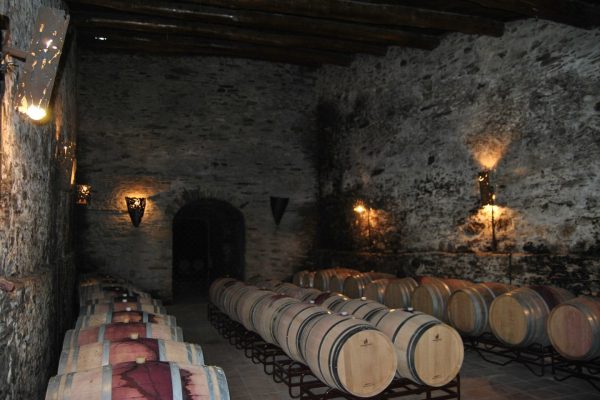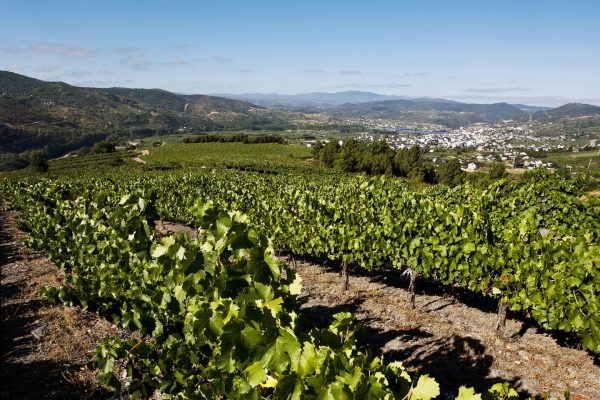
D.O. (Denomination of Origin) Valdeorras has a large diversity of soils for the surface area of vineyards it hosts; 1300 hectares.
The river Sil crosses the region from east to west, generating a symmetrically-shaped valley: steep slopes on the left bank and more gentle slopes on the right bank, essentially, in the borough councils of O Barco, A Rúa and Vilamartín.
Other rivers with a lesser volume of flow are the Xares, Bibei, Cigüeño and Casaio; in O Bolo, Larouco, Rubiá and Carballeda they fall short of forming valleys but provide sufficient slopes to cultivate vines, and terraces can be seen along the banks of the Bibei and Xares.
These southern-facing soils have always been deemed ideal for growing vines, as they are less fertile but drain well, which guarantees a more moderate yield and grapes which mature suitably.
Mediterranean-continental (with Atlantic influence).
Ideal climate for high-quality dry wines, optimum at over 450m above sea level. Valdeorras is ideal as the entire region stands at between 300m and 700m above sea level and, therefore, falls within Winkler’s zone 1.
Made from white varieties (Preferential: Godello, Loureira, Treixadura, Dona Branca, Albariño, Torrontes and Lado. Authorised: Palomino white)
If it is made:
A fizzy wine obtained using the traditional method, made with a minimum of 85% Godello grape.
Naturally sweet wine made from red varieties or from Godello.
Made from preferential red grapes (Mencía, Tempranillo, Brancellao, Merenzao, Sousón, Caíño Tinto, Espadeiro and Ferrón), or authorised red grapes (Gran Negro, Garnacha Tintureira and Mouratón).
If it is made:
According to the Specification of the D.O. Rías Baixas, the wines produced and produced must pass the verification process of the Regulatory Council. Each item of wine produced in the D.O. Rías Baixas undergoes an exhaustive control, consisting of a chemical and organoleptic analysis.
The types of wines that are distinguished within this denomination are the following:
The different finished red wines abovementioned, and Valdeorras Godello, obtained using grapes from wineries with limited production
All types of Valdeorras red and white wines subjected to aging in oak barrels can be labelled, in accordance with current legislation, Barrica, Crianza and Gran Reserva.

The tradition of Valdeorras as a wine-growing regions dates back to the days of the Roman Empire. Aided by the Mediterranean-Atlantic micro-climate, the Romans planted vines and built presses, creating a culture, secular today, which revolved around vineyards and the production of exquisite wines, whose virtues were extolled by pilgrims following the Way of St. James on their journey to Santiago de Compostela.
Ever since that time, the arduous task undertaken by winegrowers and producers would continue to bear its fruit until in 1945 Valdeorras was granted Denomination of Origin status by Ministerial Order. The Entity was born with the vocation of recovering autochthonous varieties such as Godello and Mencia, its main aims being to ensure quality, boost control, facilitate promotion and search for new ways in which to expand and market the product.


oday, winegrowing, and all that it entails, is governed by a Regulatory Council, a body that decides which wines are granted Denomination of Origin status, taking in the winegrowing borough councils of A Rúa, Carballeda de Valdeorras, Larouco, O Barco, O Bolo, Petín, Rubiá and Vilamartín.
The production areas take up a large part of the basins of the rivers Sil, Xares and Bibei. The climate is drier here than in the rest of Galicia, providing a Continental-Atlantic micro-climate. The average temperature is 11ºC and the annual rainfall ranges from 850 to 1.000 mm.
| Cookie | Duration | Description |
|---|---|---|
| __stripe_mid | 1 year | This cookie is set by Stripe payment gateway. This cookie is used to enable payment on the website without storing any patment information on a server. |
| __stripe_sid | 30 minutes | This cookie is set by Stripe payment gateway. This cookie is used to enable payment on the website without storing any patment information on a server. |
| ASP.NET_SessionId | session | This cookie is used in sites developed with Microsoft.Net. When a user start browsing a unique session ID is created, which keeps track of all the information regarding that session.This information is stored in the web server and it is identified via a GUID.The GUID is essential for any ASP.NET site to function properly. |
| AWSALBCORS | 7 days | This cookie is used for load balancing services provded by Amazon inorder to optimize the user experience. Amazon has updated the ALB and CLB so that customers can continue to use the CORS request with stickness. |
| cookielawinfo-checkbox-advertisement | 1 year | The cookie is set by GDPR cookie consent to record the user consent for the cookies in the category "Advertisement". |
| cookielawinfo-checkbox-analytics | 11 months | This cookie is set by GDPR Cookie Consent plugin. The cookie is used to store the user consent for the cookies in the category "Analytics". |
| cookielawinfo-checkbox-functional | 11 months | The cookie is set by GDPR cookie consent to record the user consent for the cookies in the category "Functional". |
| cookielawinfo-checkbox-necessary | 11 months | This cookie is set by GDPR Cookie Consent plugin. The cookies is used to store the user consent for the cookies in the category "Necessary". |
| cookielawinfo-checkbox-others | 11 months | This cookie is set by GDPR Cookie Consent plugin. The cookie is used to store the user consent for the cookies in the category "Other. |
| cookielawinfo-checkbox-performance | 11 months | This cookie is set by GDPR Cookie Consent plugin. The cookie is used to store the user consent for the cookies in the category "Performance". |
| elementor | never | This cookie is used by the website's WordPress theme. It allows the website owner to implement or change the website's content in real-time. |
| viewed_cookie_policy | 11 months | The cookie is set by the GDPR Cookie Consent plugin and is used to store whether or not user has consented to the use of cookies. It does not store any personal data. |
| Cookie | Duration | Description |
|---|---|---|
| G_ENABLED_IDPS | 99 years | The cookie is used by Google and is used for Google Single Sign On. |
| Cookie | Duration | Description |
|---|---|---|
| _ga | 2 years | This cookie is installed by Google Analytics. The cookie is used to calculate visitor, session, campaign data and keep track of site usage for the site's analytics report. The cookies store information anonymously and assign a randomly generated number to identify unique visitors. |
| _ga_8QJZRG93DN | 2 years | This cookie is installed by Google Analytics. |
| CONSENT | 16 years | These cookies are set via embedded youtube-videos. They register anonymous statistical data on for example how many times the video is displayed and what settings are used for playback.No sensitive data is collected unless you log in to your google account, in that case your choices are linked with your account, for example if you click “like” on a video. |
| Cookie | Duration | Description |
|---|---|---|
| _fbp | 3 months | This cookie is set by Facebook to deliver advertisement when they are on Facebook or a digital platform powered by Facebook advertising after visiting this website. |
| fr | 3 months | The cookie is set by Facebook to show relevant advertisments to the users and measure and improve the advertisements. The cookie also tracks the behavior of the user across the web on sites that have Facebook pixel or Facebook social plugin. |
| NID | 6 months | This cookie is used to a profile based on user's interest and display personalized ads to the users. |
| Cookie | Duration | Description |
|---|---|---|
| _swa_u | 2 years 8 months 26 days | This cookie is set by the provider Sitewit.com. This cookie is used for statistical report and analysis. |
| AWSALB | 7 days | AWSALB is a cookie generated by the Application load balancer in the Amazon Web Services. It works slightly different from AWSELB. |
| ip2location_redirection_first_visit | 1 day | No description available. |
| m | 2 years | No description available. |
| wp_woocommerce_session | 2 days | No description |